Health Promotion Report: Government Strategies, Smoking, and Health
VerifiedAdded on 2020/02/05
|11
|3784
|118
Report
AI Summary
This report delves into the multifaceted aspects of health promotion, examining the profound influence of socioeconomic factors on individual and societal well-being. It meticulously analyzes the relevance of government sources in addressing health inequalities, highlighting the critical role of strategies and programs like smoking cessation initiatives. The report explores the barriers to healthcare access, emphasizing the need for improved communication and resource allocation. Furthermore, it examines the role of health professionals in meeting government targets, outlining effective routines for quitting smoking, and discussing health benefits related to theories of health behavior. The report also addresses the potential effects of conflicts with the local industry on health promotion efforts and underscores the importance of providing relevant health-related information to the public, concluding with a comprehensive overview of the key findings and recommendations.
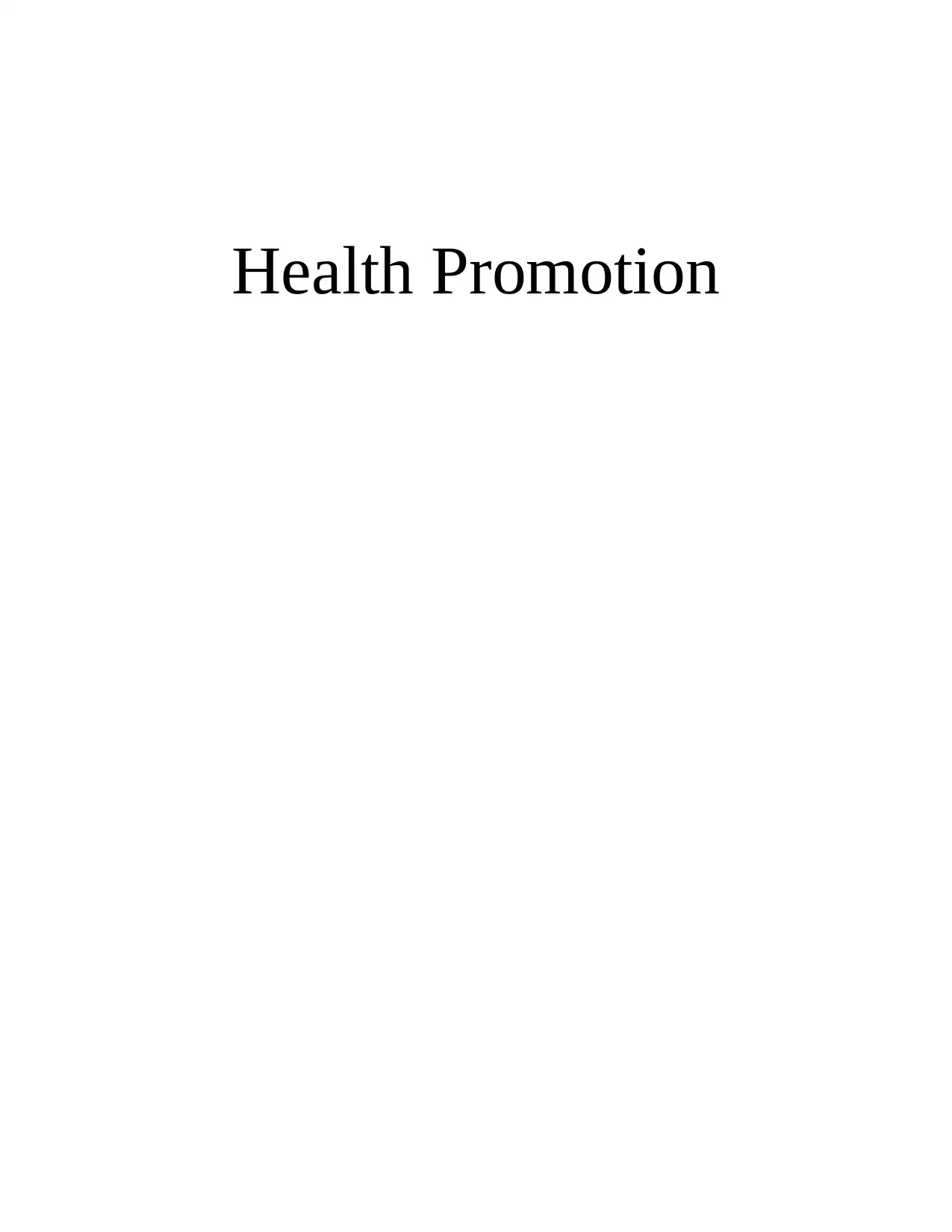
Health Promotion
Paraphrase This Document
Need a fresh take? Get an instant paraphrase of this document with our AI Paraphraser
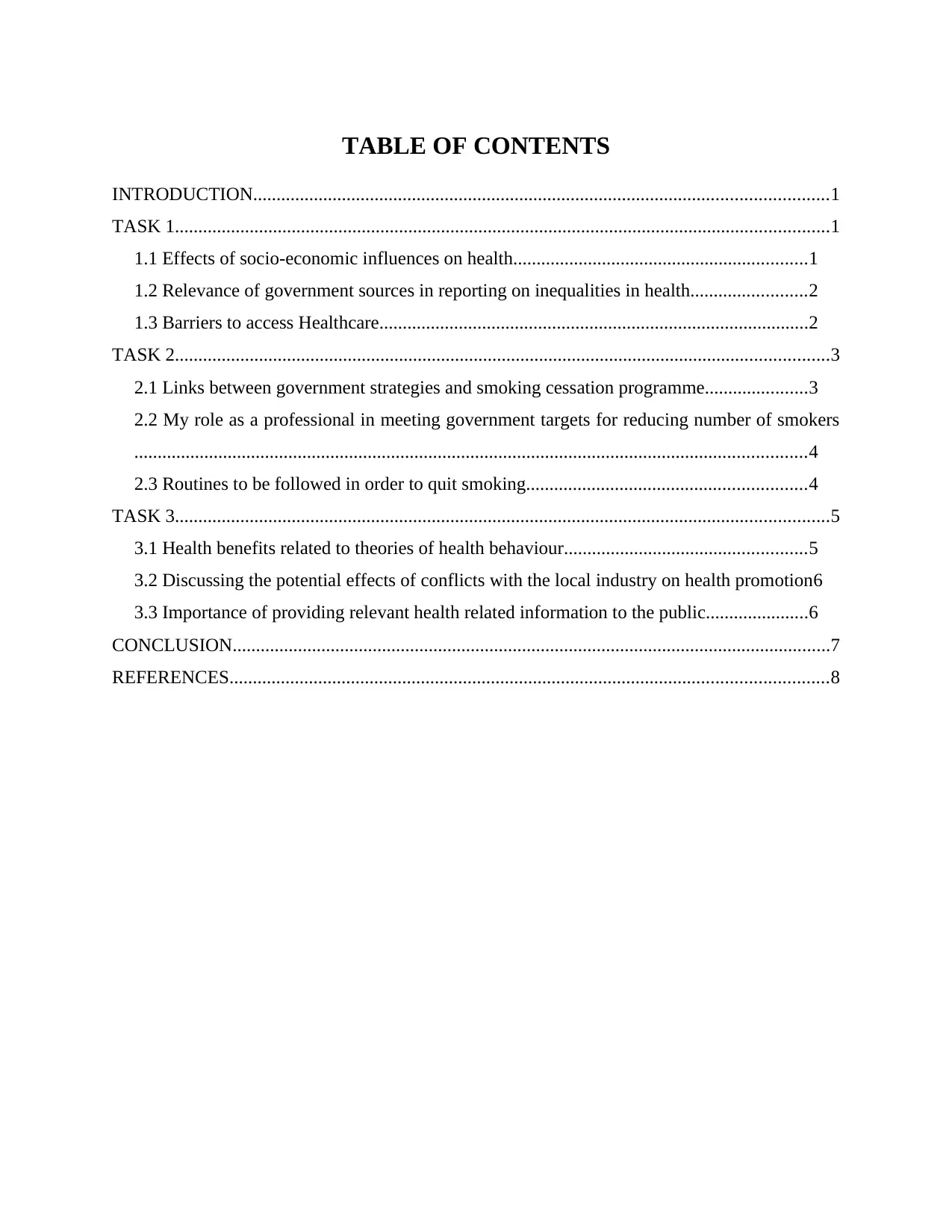
TABLE OF CONTENTS
INTRODUCTION...........................................................................................................................1
TASK 1............................................................................................................................................1
1.1 Effects of socio-economic influences on health...............................................................1
1.2 Relevance of government sources in reporting on inequalities in health.........................2
1.3 Barriers to access Healthcare............................................................................................2
TASK 2............................................................................................................................................3
2.1 Links between government strategies and smoking cessation programme......................3
2.2 My role as a professional in meeting government targets for reducing number of smokers
................................................................................................................................................4
2.3 Routines to be followed in order to quit smoking............................................................4
TASK 3............................................................................................................................................5
3.1 Health benefits related to theories of health behaviour....................................................5
3.2 Discussing the potential effects of conflicts with the local industry on health promotion6
3.3 Importance of providing relevant health related information to the public......................6
CONCLUSION................................................................................................................................7
REFERENCES................................................................................................................................8
INTRODUCTION...........................................................................................................................1
TASK 1............................................................................................................................................1
1.1 Effects of socio-economic influences on health...............................................................1
1.2 Relevance of government sources in reporting on inequalities in health.........................2
1.3 Barriers to access Healthcare............................................................................................2
TASK 2............................................................................................................................................3
2.1 Links between government strategies and smoking cessation programme......................3
2.2 My role as a professional in meeting government targets for reducing number of smokers
................................................................................................................................................4
2.3 Routines to be followed in order to quit smoking............................................................4
TASK 3............................................................................................................................................5
3.1 Health benefits related to theories of health behaviour....................................................5
3.2 Discussing the potential effects of conflicts with the local industry on health promotion6
3.3 Importance of providing relevant health related information to the public......................6
CONCLUSION................................................................................................................................7
REFERENCES................................................................................................................................8
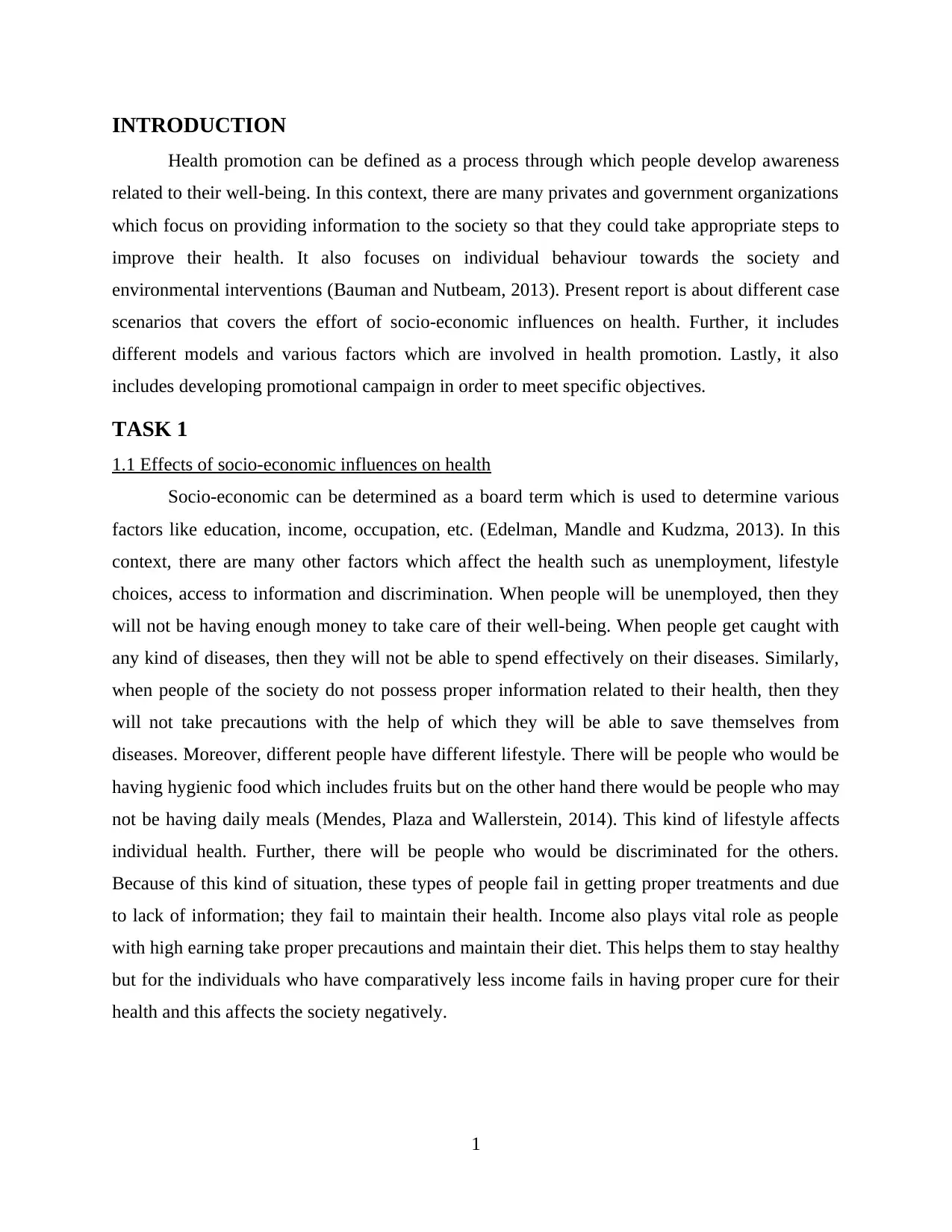
INTRODUCTION
Health promotion can be defined as a process through which people develop awareness
related to their well-being. In this context, there are many privates and government organizations
which focus on providing information to the society so that they could take appropriate steps to
improve their health. It also focuses on individual behaviour towards the society and
environmental interventions (Bauman and Nutbeam, 2013). Present report is about different case
scenarios that covers the effort of socio-economic influences on health. Further, it includes
different models and various factors which are involved in health promotion. Lastly, it also
includes developing promotional campaign in order to meet specific objectives.
TASK 1
1.1 Effects of socio-economic influences on health
Socio-economic can be determined as a board term which is used to determine various
factors like education, income, occupation, etc. (Edelman, Mandle and Kudzma, 2013). In this
context, there are many other factors which affect the health such as unemployment, lifestyle
choices, access to information and discrimination. When people will be unemployed, then they
will not be having enough money to take care of their well-being. When people get caught with
any kind of diseases, then they will not be able to spend effectively on their diseases. Similarly,
when people of the society do not possess proper information related to their health, then they
will not take precautions with the help of which they will be able to save themselves from
diseases. Moreover, different people have different lifestyle. There will be people who would be
having hygienic food which includes fruits but on the other hand there would be people who may
not be having daily meals (Mendes, Plaza and Wallerstein, 2014). This kind of lifestyle affects
individual health. Further, there will be people who would be discriminated for the others.
Because of this kind of situation, these types of people fail in getting proper treatments and due
to lack of information; they fail to maintain their health. Income also plays vital role as people
with high earning take proper precautions and maintain their diet. This helps them to stay healthy
but for the individuals who have comparatively less income fails in having proper cure for their
health and this affects the society negatively.
1
Health promotion can be defined as a process through which people develop awareness
related to their well-being. In this context, there are many privates and government organizations
which focus on providing information to the society so that they could take appropriate steps to
improve their health. It also focuses on individual behaviour towards the society and
environmental interventions (Bauman and Nutbeam, 2013). Present report is about different case
scenarios that covers the effort of socio-economic influences on health. Further, it includes
different models and various factors which are involved in health promotion. Lastly, it also
includes developing promotional campaign in order to meet specific objectives.
TASK 1
1.1 Effects of socio-economic influences on health
Socio-economic can be determined as a board term which is used to determine various
factors like education, income, occupation, etc. (Edelman, Mandle and Kudzma, 2013). In this
context, there are many other factors which affect the health such as unemployment, lifestyle
choices, access to information and discrimination. When people will be unemployed, then they
will not be having enough money to take care of their well-being. When people get caught with
any kind of diseases, then they will not be able to spend effectively on their diseases. Similarly,
when people of the society do not possess proper information related to their health, then they
will not take precautions with the help of which they will be able to save themselves from
diseases. Moreover, different people have different lifestyle. There will be people who would be
having hygienic food which includes fruits but on the other hand there would be people who may
not be having daily meals (Mendes, Plaza and Wallerstein, 2014). This kind of lifestyle affects
individual health. Further, there will be people who would be discriminated for the others.
Because of this kind of situation, these types of people fail in getting proper treatments and due
to lack of information; they fail to maintain their health. Income also plays vital role as people
with high earning take proper precautions and maintain their diet. This helps them to stay healthy
but for the individuals who have comparatively less income fails in having proper cure for their
health and this affects the society negatively.
1
⊘ This is a preview!⊘
Do you want full access?
Subscribe today to unlock all pages.

Trusted by 1+ million students worldwide
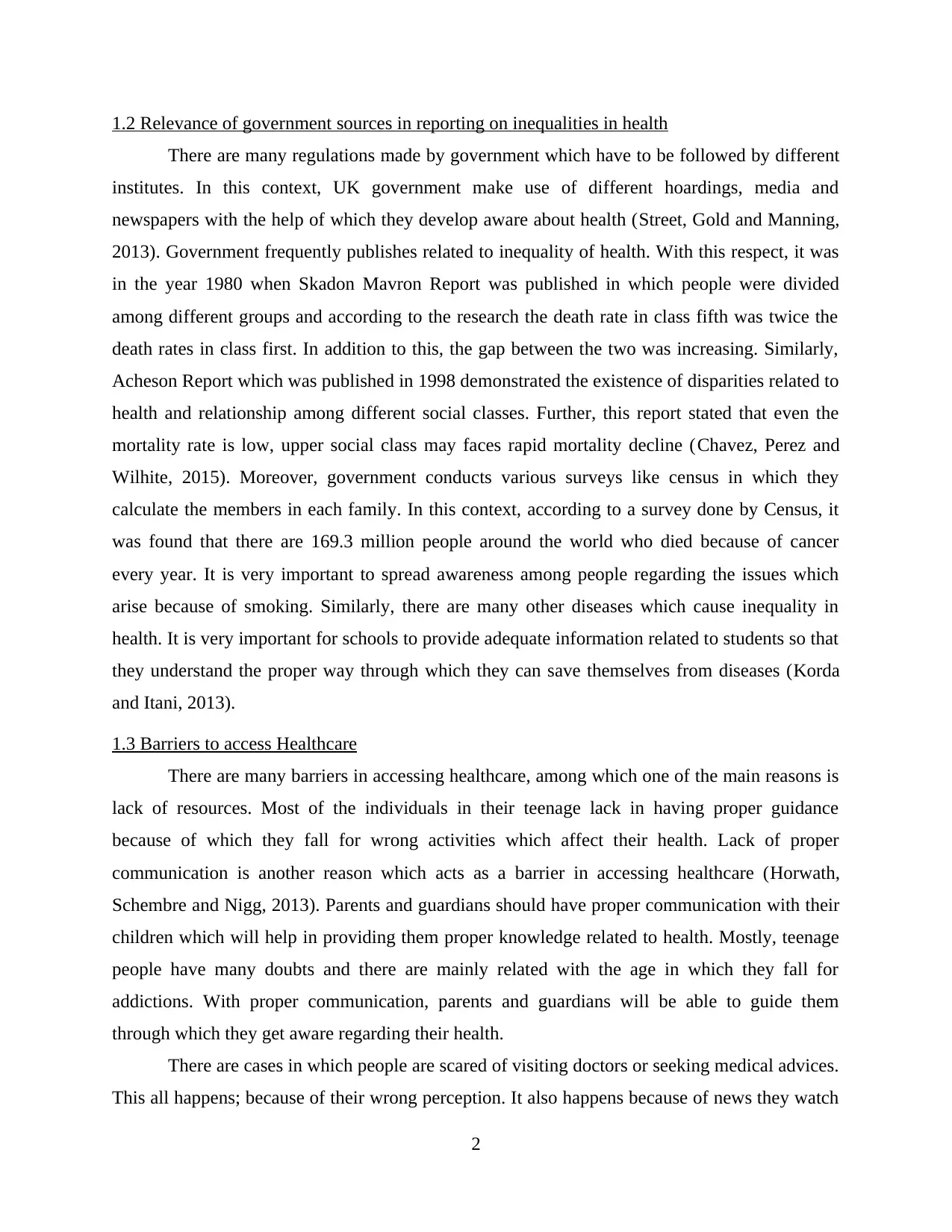
1.2 Relevance of government sources in reporting on inequalities in health
There are many regulations made by government which have to be followed by different
institutes. In this context, UK government make use of different hoardings, media and
newspapers with the help of which they develop aware about health (Street, Gold and Manning,
2013). Government frequently publishes related to inequality of health. With this respect, it was
in the year 1980 when Skadon Mavron Report was published in which people were divided
among different groups and according to the research the death rate in class fifth was twice the
death rates in class first. In addition to this, the gap between the two was increasing. Similarly,
Acheson Report which was published in 1998 demonstrated the existence of disparities related to
health and relationship among different social classes. Further, this report stated that even the
mortality rate is low, upper social class may faces rapid mortality decline (Chavez, Perez and
Wilhite, 2015). Moreover, government conducts various surveys like census in which they
calculate the members in each family. In this context, according to a survey done by Census, it
was found that there are 169.3 million people around the world who died because of cancer
every year. It is very important to spread awareness among people regarding the issues which
arise because of smoking. Similarly, there are many other diseases which cause inequality in
health. It is very important for schools to provide adequate information related to students so that
they understand the proper way through which they can save themselves from diseases (Korda
and Itani, 2013).
1.3 Barriers to access Healthcare
There are many barriers in accessing healthcare, among which one of the main reasons is
lack of resources. Most of the individuals in their teenage lack in having proper guidance
because of which they fall for wrong activities which affect their health. Lack of proper
communication is another reason which acts as a barrier in accessing healthcare (Horwath,
Schembre and Nigg, 2013). Parents and guardians should have proper communication with their
children which will help in providing them proper knowledge related to health. Mostly, teenage
people have many doubts and there are mainly related with the age in which they fall for
addictions. With proper communication, parents and guardians will be able to guide them
through which they get aware regarding their health.
There are cases in which people are scared of visiting doctors or seeking medical advices.
This all happens; because of their wrong perception. It also happens because of news they watch
2
There are many regulations made by government which have to be followed by different
institutes. In this context, UK government make use of different hoardings, media and
newspapers with the help of which they develop aware about health (Street, Gold and Manning,
2013). Government frequently publishes related to inequality of health. With this respect, it was
in the year 1980 when Skadon Mavron Report was published in which people were divided
among different groups and according to the research the death rate in class fifth was twice the
death rates in class first. In addition to this, the gap between the two was increasing. Similarly,
Acheson Report which was published in 1998 demonstrated the existence of disparities related to
health and relationship among different social classes. Further, this report stated that even the
mortality rate is low, upper social class may faces rapid mortality decline (Chavez, Perez and
Wilhite, 2015). Moreover, government conducts various surveys like census in which they
calculate the members in each family. In this context, according to a survey done by Census, it
was found that there are 169.3 million people around the world who died because of cancer
every year. It is very important to spread awareness among people regarding the issues which
arise because of smoking. Similarly, there are many other diseases which cause inequality in
health. It is very important for schools to provide adequate information related to students so that
they understand the proper way through which they can save themselves from diseases (Korda
and Itani, 2013).
1.3 Barriers to access Healthcare
There are many barriers in accessing healthcare, among which one of the main reasons is
lack of resources. Most of the individuals in their teenage lack in having proper guidance
because of which they fall for wrong activities which affect their health. Lack of proper
communication is another reason which acts as a barrier in accessing healthcare (Horwath,
Schembre and Nigg, 2013). Parents and guardians should have proper communication with their
children which will help in providing them proper knowledge related to health. Mostly, teenage
people have many doubts and there are mainly related with the age in which they fall for
addictions. With proper communication, parents and guardians will be able to guide them
through which they get aware regarding their health.
There are cases in which people are scared of visiting doctors or seeking medical advices.
This all happens; because of their wrong perception. It also happens because of news they watch
2
Paraphrase This Document
Need a fresh take? Get an instant paraphrase of this document with our AI Paraphraser
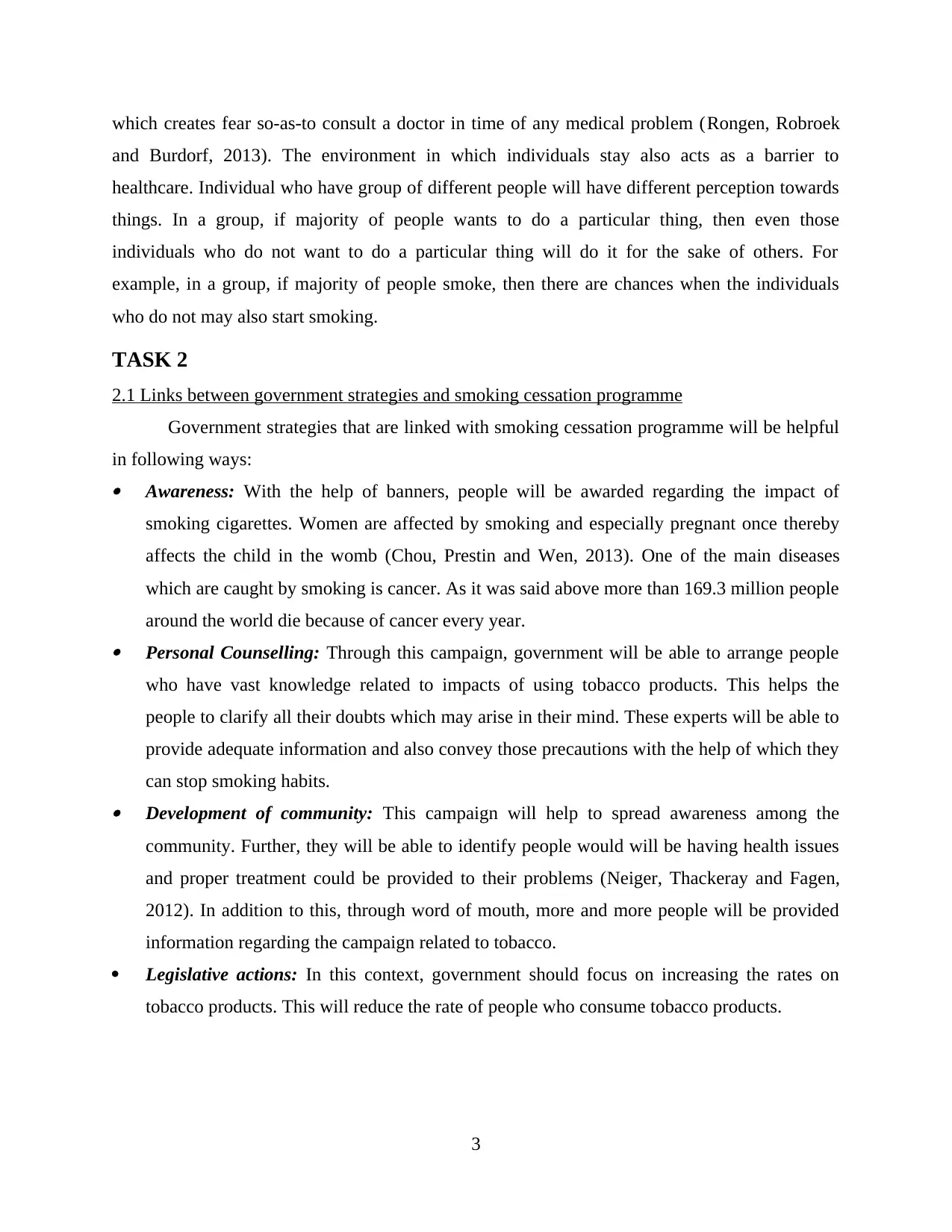
which creates fear so-as-to consult a doctor in time of any medical problem (Rongen, Robroek
and Burdorf, 2013). The environment in which individuals stay also acts as a barrier to
healthcare. Individual who have group of different people will have different perception towards
things. In a group, if majority of people wants to do a particular thing, then even those
individuals who do not want to do a particular thing will do it for the sake of others. For
example, in a group, if majority of people smoke, then there are chances when the individuals
who do not may also start smoking.
TASK 2
2.1 Links between government strategies and smoking cessation programme
Government strategies that are linked with smoking cessation programme will be helpful
in following ways: Awareness: With the help of banners, people will be awarded regarding the impact of
smoking cigarettes. Women are affected by smoking and especially pregnant once thereby
affects the child in the womb (Chou, Prestin and Wen, 2013). One of the main diseases
which are caught by smoking is cancer. As it was said above more than 169.3 million people
around the world die because of cancer every year. Personal Counselling: Through this campaign, government will be able to arrange people
who have vast knowledge related to impacts of using tobacco products. This helps the
people to clarify all their doubts which may arise in their mind. These experts will be able to
provide adequate information and also convey those precautions with the help of which they
can stop smoking habits. Development of community: This campaign will help to spread awareness among the
community. Further, they will be able to identify people would will be having health issues
and proper treatment could be provided to their problems (Neiger, Thackeray and Fagen,
2012). In addition to this, through word of mouth, more and more people will be provided
information regarding the campaign related to tobacco.
Legislative actions: In this context, government should focus on increasing the rates on
tobacco products. This will reduce the rate of people who consume tobacco products.
3
and Burdorf, 2013). The environment in which individuals stay also acts as a barrier to
healthcare. Individual who have group of different people will have different perception towards
things. In a group, if majority of people wants to do a particular thing, then even those
individuals who do not want to do a particular thing will do it for the sake of others. For
example, in a group, if majority of people smoke, then there are chances when the individuals
who do not may also start smoking.
TASK 2
2.1 Links between government strategies and smoking cessation programme
Government strategies that are linked with smoking cessation programme will be helpful
in following ways: Awareness: With the help of banners, people will be awarded regarding the impact of
smoking cigarettes. Women are affected by smoking and especially pregnant once thereby
affects the child in the womb (Chou, Prestin and Wen, 2013). One of the main diseases
which are caught by smoking is cancer. As it was said above more than 169.3 million people
around the world die because of cancer every year. Personal Counselling: Through this campaign, government will be able to arrange people
who have vast knowledge related to impacts of using tobacco products. This helps the
people to clarify all their doubts which may arise in their mind. These experts will be able to
provide adequate information and also convey those precautions with the help of which they
can stop smoking habits. Development of community: This campaign will help to spread awareness among the
community. Further, they will be able to identify people would will be having health issues
and proper treatment could be provided to their problems (Neiger, Thackeray and Fagen,
2012). In addition to this, through word of mouth, more and more people will be provided
information regarding the campaign related to tobacco.
Legislative actions: In this context, government should focus on increasing the rates on
tobacco products. This will reduce the rate of people who consume tobacco products.
3
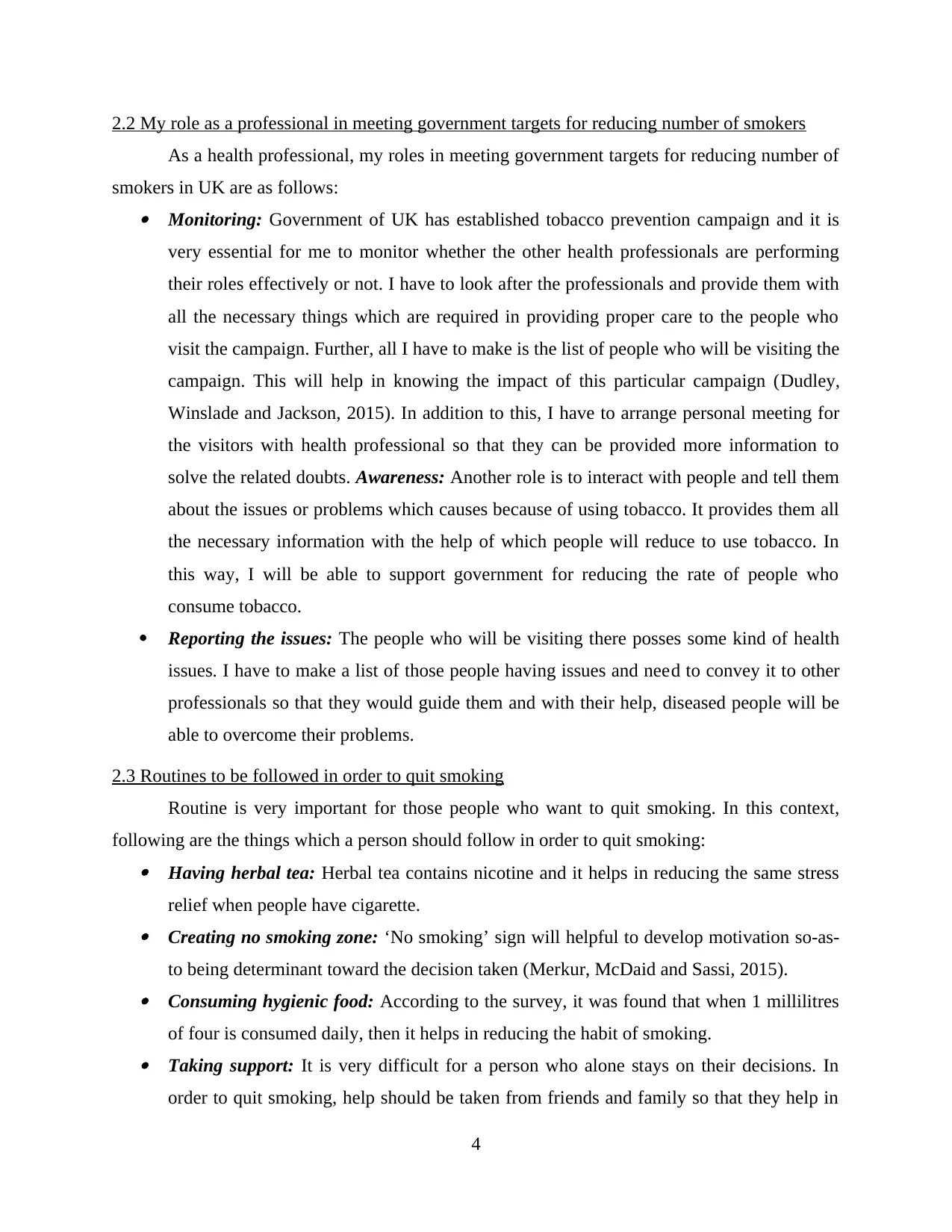
2.2 My role as a professional in meeting government targets for reducing number of smokers
As a health professional, my roles in meeting government targets for reducing number of
smokers in UK are as follows: Monitoring: Government of UK has established tobacco prevention campaign and it is
very essential for me to monitor whether the other health professionals are performing
their roles effectively or not. I have to look after the professionals and provide them with
all the necessary things which are required in providing proper care to the people who
visit the campaign. Further, all I have to make is the list of people who will be visiting the
campaign. This will help in knowing the impact of this particular campaign (Dudley,
Winslade and Jackson, 2015). In addition to this, I have to arrange personal meeting for
the visitors with health professional so that they can be provided more information to
solve the related doubts. Awareness: Another role is to interact with people and tell them
about the issues or problems which causes because of using tobacco. It provides them all
the necessary information with the help of which people will reduce to use tobacco. In
this way, I will be able to support government for reducing the rate of people who
consume tobacco.
Reporting the issues: The people who will be visiting there posses some kind of health
issues. I have to make a list of those people having issues and need to convey it to other
professionals so that they would guide them and with their help, diseased people will be
able to overcome their problems.
2.3 Routines to be followed in order to quit smoking
Routine is very important for those people who want to quit smoking. In this context,
following are the things which a person should follow in order to quit smoking: Having herbal tea: Herbal tea contains nicotine and it helps in reducing the same stress
relief when people have cigarette. Creating no smoking zone: ‘No smoking’ sign will helpful to develop motivation so-as-
to being determinant toward the decision taken (Merkur, McDaid and Sassi, 2015). Consuming hygienic food: According to the survey, it was found that when 1 millilitres
of four is consumed daily, then it helps in reducing the habit of smoking. Taking support: It is very difficult for a person who alone stays on their decisions. In
order to quit smoking, help should be taken from friends and family so that they help in
4
As a health professional, my roles in meeting government targets for reducing number of
smokers in UK are as follows: Monitoring: Government of UK has established tobacco prevention campaign and it is
very essential for me to monitor whether the other health professionals are performing
their roles effectively or not. I have to look after the professionals and provide them with
all the necessary things which are required in providing proper care to the people who
visit the campaign. Further, all I have to make is the list of people who will be visiting the
campaign. This will help in knowing the impact of this particular campaign (Dudley,
Winslade and Jackson, 2015). In addition to this, I have to arrange personal meeting for
the visitors with health professional so that they can be provided more information to
solve the related doubts. Awareness: Another role is to interact with people and tell them
about the issues or problems which causes because of using tobacco. It provides them all
the necessary information with the help of which people will reduce to use tobacco. In
this way, I will be able to support government for reducing the rate of people who
consume tobacco.
Reporting the issues: The people who will be visiting there posses some kind of health
issues. I have to make a list of those people having issues and need to convey it to other
professionals so that they would guide them and with their help, diseased people will be
able to overcome their problems.
2.3 Routines to be followed in order to quit smoking
Routine is very important for those people who want to quit smoking. In this context,
following are the things which a person should follow in order to quit smoking: Having herbal tea: Herbal tea contains nicotine and it helps in reducing the same stress
relief when people have cigarette. Creating no smoking zone: ‘No smoking’ sign will helpful to develop motivation so-as-
to being determinant toward the decision taken (Merkur, McDaid and Sassi, 2015). Consuming hygienic food: According to the survey, it was found that when 1 millilitres
of four is consumed daily, then it helps in reducing the habit of smoking. Taking support: It is very difficult for a person who alone stays on their decisions. In
order to quit smoking, help should be taken from friends and family so that they help in
4
⊘ This is a preview!⊘
Do you want full access?
Subscribe today to unlock all pages.

Trusted by 1+ million students worldwide
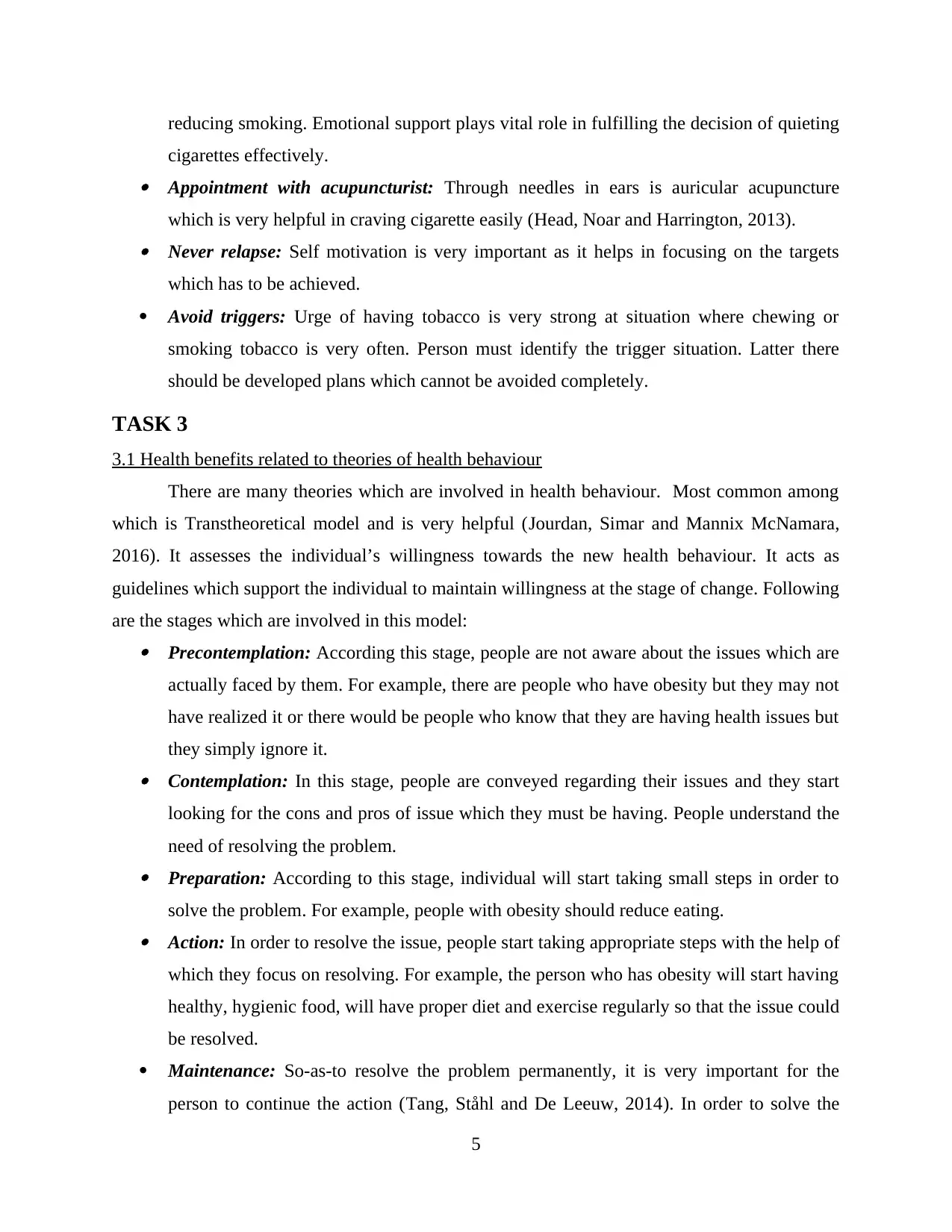
reducing smoking. Emotional support plays vital role in fulfilling the decision of quieting
cigarettes effectively. Appointment with acupuncturist: Through needles in ears is auricular acupuncture
which is very helpful in craving cigarette easily (Head, Noar and Harrington, 2013). Never relapse: Self motivation is very important as it helps in focusing on the targets
which has to be achieved.
Avoid triggers: Urge of having tobacco is very strong at situation where chewing or
smoking tobacco is very often. Person must identify the trigger situation. Latter there
should be developed plans which cannot be avoided completely.
TASK 3
3.1 Health benefits related to theories of health behaviour
There are many theories which are involved in health behaviour. Most common among
which is Transtheoretical model and is very helpful (Jourdan, Simar and Mannix McNamara,
2016). It assesses the individual’s willingness towards the new health behaviour. It acts as
guidelines which support the individual to maintain willingness at the stage of change. Following
are the stages which are involved in this model: Precontemplation: According this stage, people are not aware about the issues which are
actually faced by them. For example, there are people who have obesity but they may not
have realized it or there would be people who know that they are having health issues but
they simply ignore it. Contemplation: In this stage, people are conveyed regarding their issues and they start
looking for the cons and pros of issue which they must be having. People understand the
need of resolving the problem. Preparation: According to this stage, individual will start taking small steps in order to
solve the problem. For example, people with obesity should reduce eating. Action: In order to resolve the issue, people start taking appropriate steps with the help of
which they focus on resolving. For example, the person who has obesity will start having
healthy, hygienic food, will have proper diet and exercise regularly so that the issue could
be resolved.
Maintenance: So-as-to resolve the problem permanently, it is very important for the
person to continue the action (Tang, Ståhl and De Leeuw, 2014). In order to solve the
5
cigarettes effectively. Appointment with acupuncturist: Through needles in ears is auricular acupuncture
which is very helpful in craving cigarette easily (Head, Noar and Harrington, 2013). Never relapse: Self motivation is very important as it helps in focusing on the targets
which has to be achieved.
Avoid triggers: Urge of having tobacco is very strong at situation where chewing or
smoking tobacco is very often. Person must identify the trigger situation. Latter there
should be developed plans which cannot be avoided completely.
TASK 3
3.1 Health benefits related to theories of health behaviour
There are many theories which are involved in health behaviour. Most common among
which is Transtheoretical model and is very helpful (Jourdan, Simar and Mannix McNamara,
2016). It assesses the individual’s willingness towards the new health behaviour. It acts as
guidelines which support the individual to maintain willingness at the stage of change. Following
are the stages which are involved in this model: Precontemplation: According this stage, people are not aware about the issues which are
actually faced by them. For example, there are people who have obesity but they may not
have realized it or there would be people who know that they are having health issues but
they simply ignore it. Contemplation: In this stage, people are conveyed regarding their issues and they start
looking for the cons and pros of issue which they must be having. People understand the
need of resolving the problem. Preparation: According to this stage, individual will start taking small steps in order to
solve the problem. For example, people with obesity should reduce eating. Action: In order to resolve the issue, people start taking appropriate steps with the help of
which they focus on resolving. For example, the person who has obesity will start having
healthy, hygienic food, will have proper diet and exercise regularly so that the issue could
be resolved.
Maintenance: So-as-to resolve the problem permanently, it is very important for the
person to continue the action (Tang, Ståhl and De Leeuw, 2014). In order to solve the
5
Paraphrase This Document
Need a fresh take? Get an instant paraphrase of this document with our AI Paraphraser
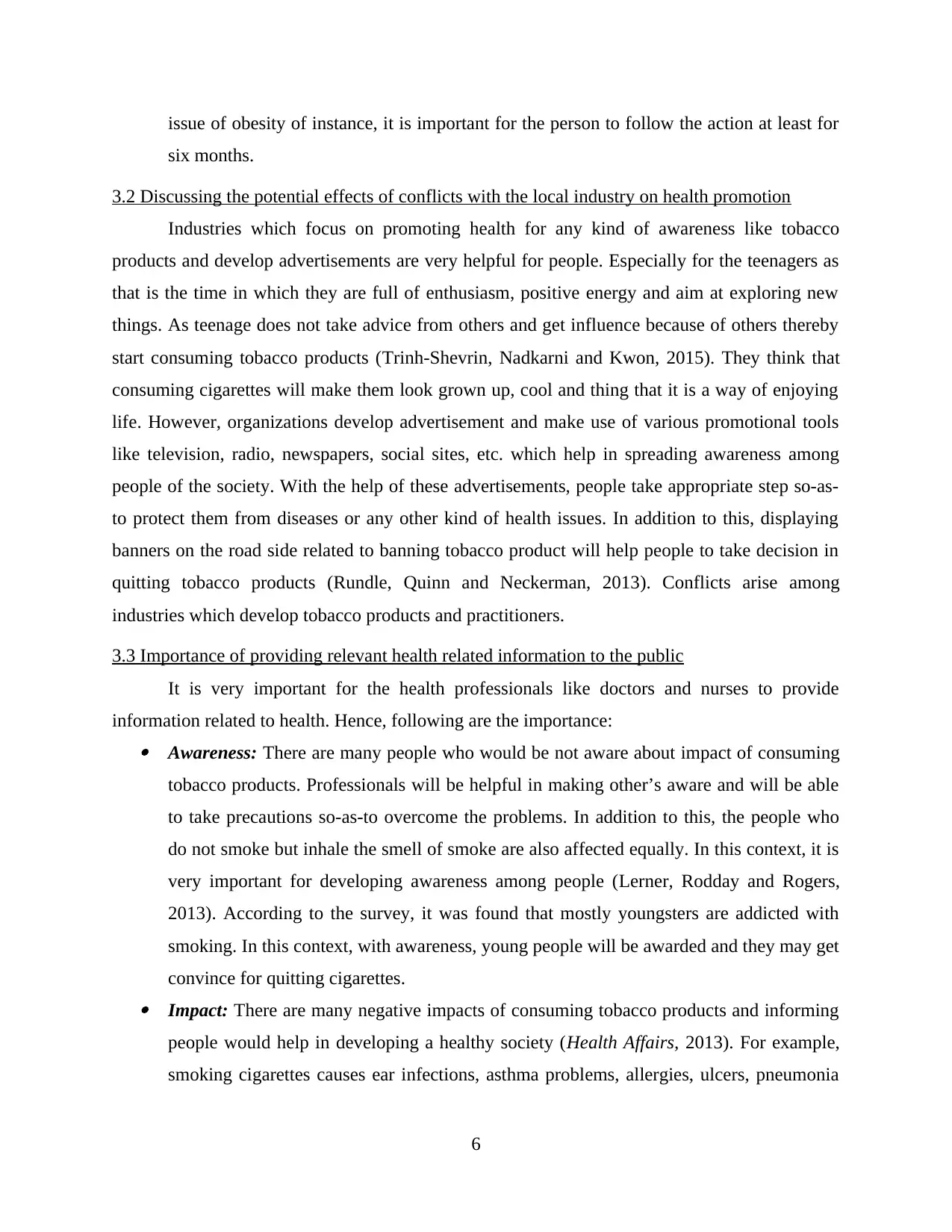
issue of obesity of instance, it is important for the person to follow the action at least for
six months.
3.2 Discussing the potential effects of conflicts with the local industry on health promotion
Industries which focus on promoting health for any kind of awareness like tobacco
products and develop advertisements are very helpful for people. Especially for the teenagers as
that is the time in which they are full of enthusiasm, positive energy and aim at exploring new
things. As teenage does not take advice from others and get influence because of others thereby
start consuming tobacco products (Trinh-Shevrin, Nadkarni and Kwon, 2015). They think that
consuming cigarettes will make them look grown up, cool and thing that it is a way of enjoying
life. However, organizations develop advertisement and make use of various promotional tools
like television, radio, newspapers, social sites, etc. which help in spreading awareness among
people of the society. With the help of these advertisements, people take appropriate step so-as-
to protect them from diseases or any other kind of health issues. In addition to this, displaying
banners on the road side related to banning tobacco product will help people to take decision in
quitting tobacco products (Rundle, Quinn and Neckerman, 2013). Conflicts arise among
industries which develop tobacco products and practitioners.
3.3 Importance of providing relevant health related information to the public
It is very important for the health professionals like doctors and nurses to provide
information related to health. Hence, following are the importance: Awareness: There are many people who would be not aware about impact of consuming
tobacco products. Professionals will be helpful in making other’s aware and will be able
to take precautions so-as-to overcome the problems. In addition to this, the people who
do not smoke but inhale the smell of smoke are also affected equally. In this context, it is
very important for developing awareness among people (Lerner, Rodday and Rogers,
2013). According to the survey, it was found that mostly youngsters are addicted with
smoking. In this context, with awareness, young people will be awarded and they may get
convince for quitting cigarettes. Impact: There are many negative impacts of consuming tobacco products and informing
people would help in developing a healthy society (Health Affairs, 2013). For example,
smoking cigarettes causes ear infections, asthma problems, allergies, ulcers, pneumonia
6
six months.
3.2 Discussing the potential effects of conflicts with the local industry on health promotion
Industries which focus on promoting health for any kind of awareness like tobacco
products and develop advertisements are very helpful for people. Especially for the teenagers as
that is the time in which they are full of enthusiasm, positive energy and aim at exploring new
things. As teenage does not take advice from others and get influence because of others thereby
start consuming tobacco products (Trinh-Shevrin, Nadkarni and Kwon, 2015). They think that
consuming cigarettes will make them look grown up, cool and thing that it is a way of enjoying
life. However, organizations develop advertisement and make use of various promotional tools
like television, radio, newspapers, social sites, etc. which help in spreading awareness among
people of the society. With the help of these advertisements, people take appropriate step so-as-
to protect them from diseases or any other kind of health issues. In addition to this, displaying
banners on the road side related to banning tobacco product will help people to take decision in
quitting tobacco products (Rundle, Quinn and Neckerman, 2013). Conflicts arise among
industries which develop tobacco products and practitioners.
3.3 Importance of providing relevant health related information to the public
It is very important for the health professionals like doctors and nurses to provide
information related to health. Hence, following are the importance: Awareness: There are many people who would be not aware about impact of consuming
tobacco products. Professionals will be helpful in making other’s aware and will be able
to take precautions so-as-to overcome the problems. In addition to this, the people who
do not smoke but inhale the smell of smoke are also affected equally. In this context, it is
very important for developing awareness among people (Lerner, Rodday and Rogers,
2013). According to the survey, it was found that mostly youngsters are addicted with
smoking. In this context, with awareness, young people will be awarded and they may get
convince for quitting cigarettes. Impact: There are many negative impacts of consuming tobacco products and informing
people would help in developing a healthy society (Health Affairs, 2013). For example,
smoking cigarettes causes ear infections, asthma problems, allergies, ulcers, pneumonia
6
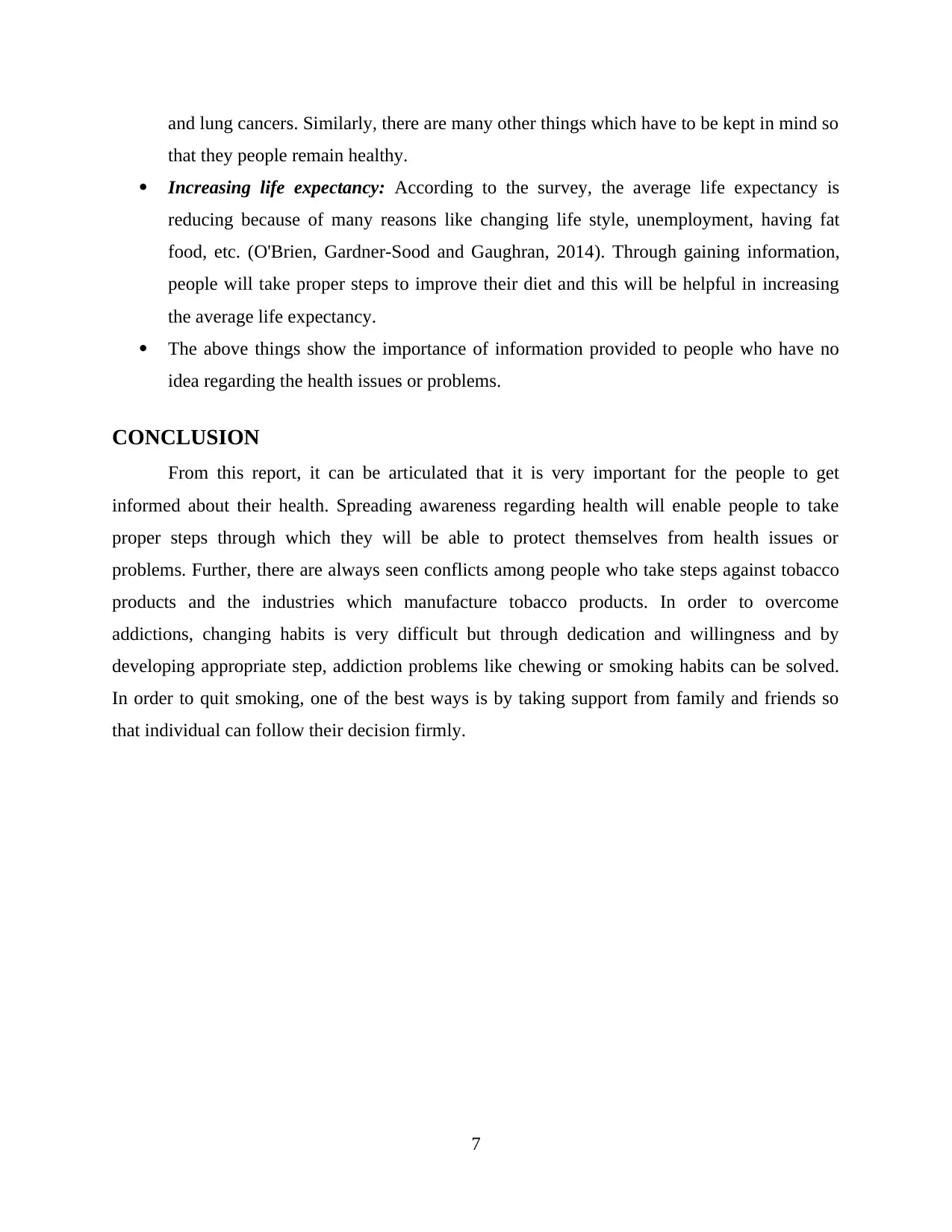
and lung cancers. Similarly, there are many other things which have to be kept in mind so
that they people remain healthy.
Increasing life expectancy: According to the survey, the average life expectancy is
reducing because of many reasons like changing life style, unemployment, having fat
food, etc. (O'Brien, Gardner‐Sood and Gaughran, 2014). Through gaining information,
people will take proper steps to improve their diet and this will be helpful in increasing
the average life expectancy.
The above things show the importance of information provided to people who have no
idea regarding the health issues or problems.
CONCLUSION
From this report, it can be articulated that it is very important for the people to get
informed about their health. Spreading awareness regarding health will enable people to take
proper steps through which they will be able to protect themselves from health issues or
problems. Further, there are always seen conflicts among people who take steps against tobacco
products and the industries which manufacture tobacco products. In order to overcome
addictions, changing habits is very difficult but through dedication and willingness and by
developing appropriate step, addiction problems like chewing or smoking habits can be solved.
In order to quit smoking, one of the best ways is by taking support from family and friends so
that individual can follow their decision firmly.
7
that they people remain healthy.
Increasing life expectancy: According to the survey, the average life expectancy is
reducing because of many reasons like changing life style, unemployment, having fat
food, etc. (O'Brien, Gardner‐Sood and Gaughran, 2014). Through gaining information,
people will take proper steps to improve their diet and this will be helpful in increasing
the average life expectancy.
The above things show the importance of information provided to people who have no
idea regarding the health issues or problems.
CONCLUSION
From this report, it can be articulated that it is very important for the people to get
informed about their health. Spreading awareness regarding health will enable people to take
proper steps through which they will be able to protect themselves from health issues or
problems. Further, there are always seen conflicts among people who take steps against tobacco
products and the industries which manufacture tobacco products. In order to overcome
addictions, changing habits is very difficult but through dedication and willingness and by
developing appropriate step, addiction problems like chewing or smoking habits can be solved.
In order to quit smoking, one of the best ways is by taking support from family and friends so
that individual can follow their decision firmly.
7
⊘ This is a preview!⊘
Do you want full access?
Subscribe today to unlock all pages.

Trusted by 1+ million students worldwide
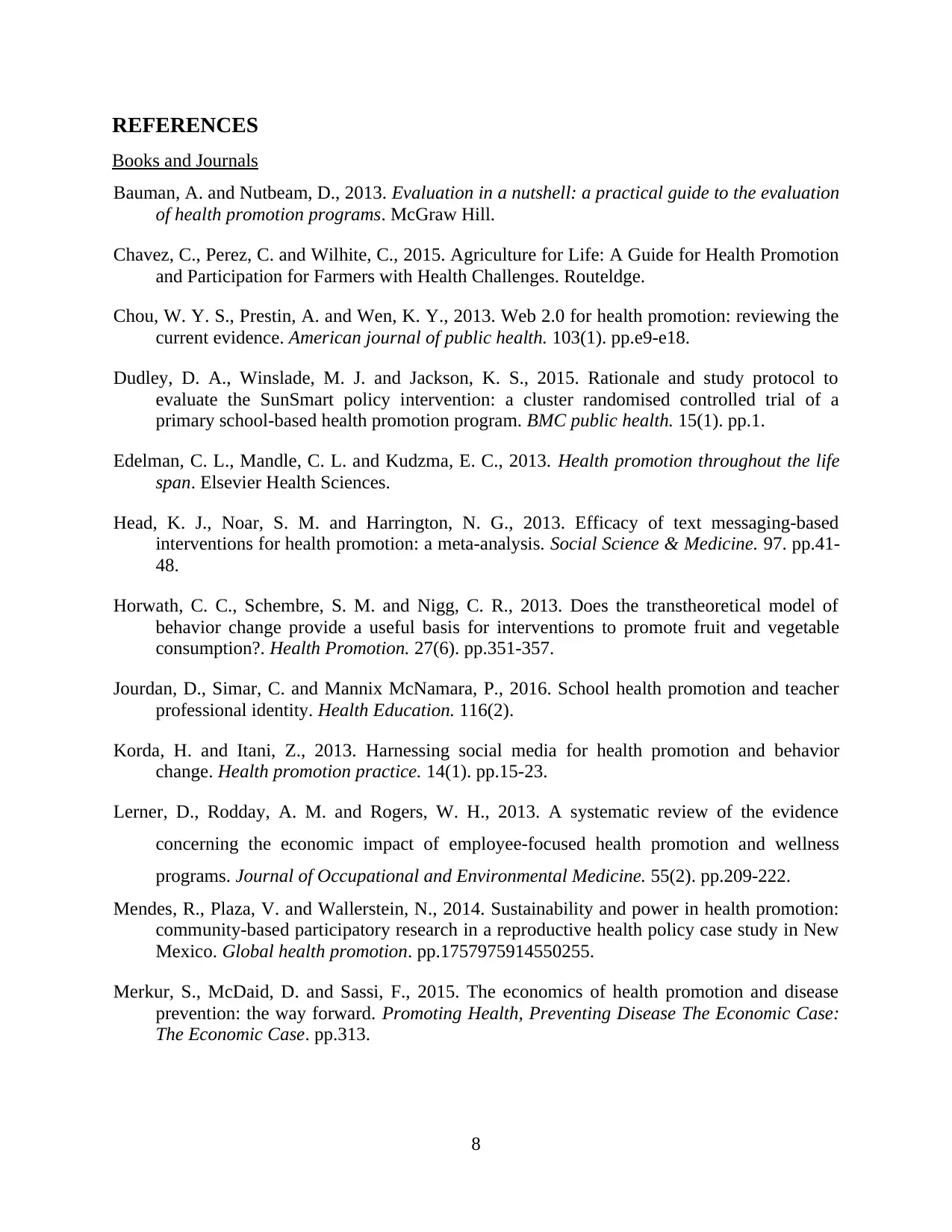
REFERENCES
Books and Journals
Bauman, A. and Nutbeam, D., 2013. Evaluation in a nutshell: a practical guide to the evaluation
of health promotion programs. McGraw Hill.
Chavez, C., Perez, C. and Wilhite, C., 2015. Agriculture for Life: A Guide for Health Promotion
and Participation for Farmers with Health Challenges. Routeldge.
Chou, W. Y. S., Prestin, A. and Wen, K. Y., 2013. Web 2.0 for health promotion: reviewing the
current evidence. American journal of public health. 103(1). pp.e9-e18.
Dudley, D. A., Winslade, M. J. and Jackson, K. S., 2015. Rationale and study protocol to
evaluate the SunSmart policy intervention: a cluster randomised controlled trial of a
primary school-based health promotion program. BMC public health. 15(1). pp.1.
Edelman, C. L., Mandle, C. L. and Kudzma, E. C., 2013. Health promotion throughout the life
span. Elsevier Health Sciences.
Head, K. J., Noar, S. M. and Harrington, N. G., 2013. Efficacy of text messaging-based
interventions for health promotion: a meta-analysis. Social Science & Medicine. 97. pp.41-
48.
Horwath, C. C., Schembre, S. M. and Nigg, C. R., 2013. Does the transtheoretical model of
behavior change provide a useful basis for interventions to promote fruit and vegetable
consumption?. Health Promotion. 27(6). pp.351-357.
Jourdan, D., Simar, C. and Mannix McNamara, P., 2016. School health promotion and teacher
professional identity. Health Education. 116(2).
Korda, H. and Itani, Z., 2013. Harnessing social media for health promotion and behavior
change. Health promotion practice. 14(1). pp.15-23.
Lerner, D., Rodday, A. M. and Rogers, W. H., 2013. A systematic review of the evidence
concerning the economic impact of employee-focused health promotion and wellness
programs. Journal of Occupational and Environmental Medicine. 55(2). pp.209-222.
Mendes, R., Plaza, V. and Wallerstein, N., 2014. Sustainability and power in health promotion:
community-based participatory research in a reproductive health policy case study in New
Mexico. Global health promotion. pp.1757975914550255.
Merkur, S., McDaid, D. and Sassi, F., 2015. The economics of health promotion and disease
prevention: the way forward. Promoting Health, Preventing Disease The Economic Case:
The Economic Case. pp.313.
8
Books and Journals
Bauman, A. and Nutbeam, D., 2013. Evaluation in a nutshell: a practical guide to the evaluation
of health promotion programs. McGraw Hill.
Chavez, C., Perez, C. and Wilhite, C., 2015. Agriculture for Life: A Guide for Health Promotion
and Participation for Farmers with Health Challenges. Routeldge.
Chou, W. Y. S., Prestin, A. and Wen, K. Y., 2013. Web 2.0 for health promotion: reviewing the
current evidence. American journal of public health. 103(1). pp.e9-e18.
Dudley, D. A., Winslade, M. J. and Jackson, K. S., 2015. Rationale and study protocol to
evaluate the SunSmart policy intervention: a cluster randomised controlled trial of a
primary school-based health promotion program. BMC public health. 15(1). pp.1.
Edelman, C. L., Mandle, C. L. and Kudzma, E. C., 2013. Health promotion throughout the life
span. Elsevier Health Sciences.
Head, K. J., Noar, S. M. and Harrington, N. G., 2013. Efficacy of text messaging-based
interventions for health promotion: a meta-analysis. Social Science & Medicine. 97. pp.41-
48.
Horwath, C. C., Schembre, S. M. and Nigg, C. R., 2013. Does the transtheoretical model of
behavior change provide a useful basis for interventions to promote fruit and vegetable
consumption?. Health Promotion. 27(6). pp.351-357.
Jourdan, D., Simar, C. and Mannix McNamara, P., 2016. School health promotion and teacher
professional identity. Health Education. 116(2).
Korda, H. and Itani, Z., 2013. Harnessing social media for health promotion and behavior
change. Health promotion practice. 14(1). pp.15-23.
Lerner, D., Rodday, A. M. and Rogers, W. H., 2013. A systematic review of the evidence
concerning the economic impact of employee-focused health promotion and wellness
programs. Journal of Occupational and Environmental Medicine. 55(2). pp.209-222.
Mendes, R., Plaza, V. and Wallerstein, N., 2014. Sustainability and power in health promotion:
community-based participatory research in a reproductive health policy case study in New
Mexico. Global health promotion. pp.1757975914550255.
Merkur, S., McDaid, D. and Sassi, F., 2015. The economics of health promotion and disease
prevention: the way forward. Promoting Health, Preventing Disease The Economic Case:
The Economic Case. pp.313.
8
Paraphrase This Document
Need a fresh take? Get an instant paraphrase of this document with our AI Paraphraser
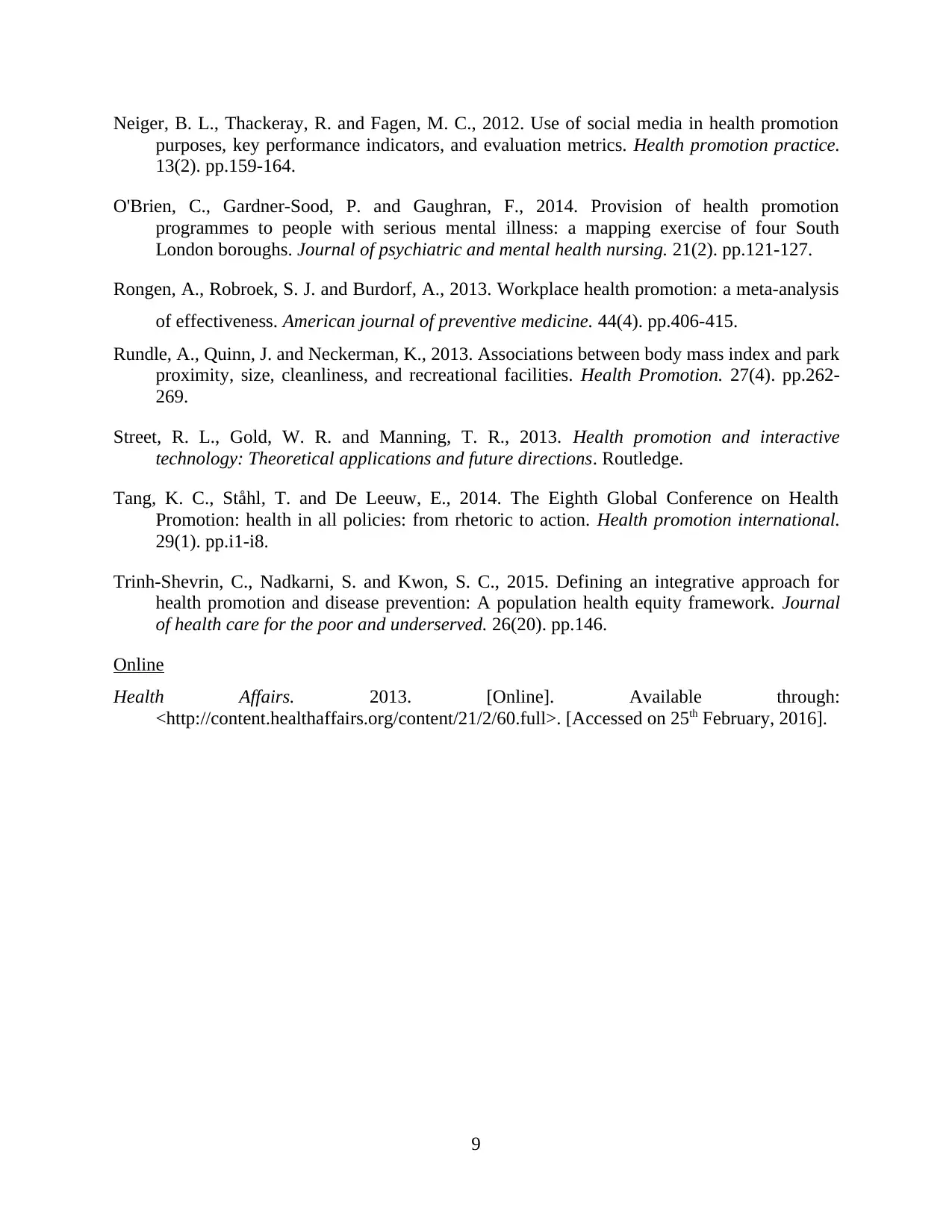
Neiger, B. L., Thackeray, R. and Fagen, M. C., 2012. Use of social media in health promotion
purposes, key performance indicators, and evaluation metrics. Health promotion practice.
13(2). pp.159-164.
O'Brien, C., Gardner‐Sood, P. and Gaughran, F., 2014. Provision of health promotion
programmes to people with serious mental illness: a mapping exercise of four South
London boroughs. Journal of psychiatric and mental health nursing. 21(2). pp.121-127.
Rongen, A., Robroek, S. J. and Burdorf, A., 2013. Workplace health promotion: a meta-analysis
of effectiveness. American journal of preventive medicine. 44(4). pp.406-415.
Rundle, A., Quinn, J. and Neckerman, K., 2013. Associations between body mass index and park
proximity, size, cleanliness, and recreational facilities. Health Promotion. 27(4). pp.262-
269.
Street, R. L., Gold, W. R. and Manning, T. R., 2013. Health promotion and interactive
technology: Theoretical applications and future directions. Routledge.
Tang, K. C., Ståhl, T. and De Leeuw, E., 2014. The Eighth Global Conference on Health
Promotion: health in all policies: from rhetoric to action. Health promotion international.
29(1). pp.i1-i8.
Trinh-Shevrin, C., Nadkarni, S. and Kwon, S. C., 2015. Defining an integrative approach for
health promotion and disease prevention: A population health equity framework. Journal
of health care for the poor and underserved. 26(20). pp.146.
Online
Health Affairs. 2013. [Online]. Available through:
<http://content.healthaffairs.org/content/21/2/60.full>. [Accessed on 25th February, 2016].
9
purposes, key performance indicators, and evaluation metrics. Health promotion practice.
13(2). pp.159-164.
O'Brien, C., Gardner‐Sood, P. and Gaughran, F., 2014. Provision of health promotion
programmes to people with serious mental illness: a mapping exercise of four South
London boroughs. Journal of psychiatric and mental health nursing. 21(2). pp.121-127.
Rongen, A., Robroek, S. J. and Burdorf, A., 2013. Workplace health promotion: a meta-analysis
of effectiveness. American journal of preventive medicine. 44(4). pp.406-415.
Rundle, A., Quinn, J. and Neckerman, K., 2013. Associations between body mass index and park
proximity, size, cleanliness, and recreational facilities. Health Promotion. 27(4). pp.262-
269.
Street, R. L., Gold, W. R. and Manning, T. R., 2013. Health promotion and interactive
technology: Theoretical applications and future directions. Routledge.
Tang, K. C., Ståhl, T. and De Leeuw, E., 2014. The Eighth Global Conference on Health
Promotion: health in all policies: from rhetoric to action. Health promotion international.
29(1). pp.i1-i8.
Trinh-Shevrin, C., Nadkarni, S. and Kwon, S. C., 2015. Defining an integrative approach for
health promotion and disease prevention: A population health equity framework. Journal
of health care for the poor and underserved. 26(20). pp.146.
Online
Health Affairs. 2013. [Online]. Available through:
<http://content.healthaffairs.org/content/21/2/60.full>. [Accessed on 25th February, 2016].
9
1 out of 11
Related Documents
Your All-in-One AI-Powered Toolkit for Academic Success.
+13062052269
info@desklib.com
Available 24*7 on WhatsApp / Email
![[object Object]](/_next/static/media/star-bottom.7253800d.svg)
Unlock your academic potential
Copyright © 2020–2025 A2Z Services. All Rights Reserved. Developed and managed by ZUCOL.





